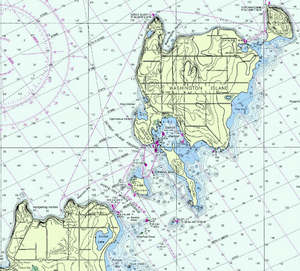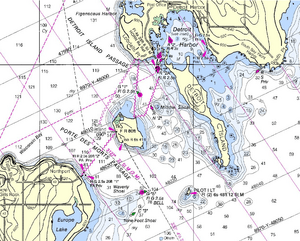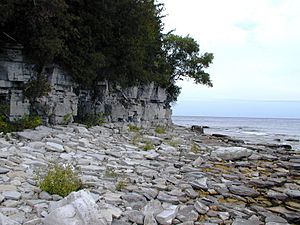Porte des Morts facts for kids
Porte des Morts, also known as Death's Door, is a famous strait (a narrow water passage) in Wisconsin. It connects Lake Michigan with Green Bay. This strait is located between the northern tip of Door County, Wisconsin and a group of islands, with Washington Island being the largest. The name "Porte des Morts" is French and means "the door of the dead."
Contents
How Water Moves in Death's Door
In this strait, warm water from Green Bay flows into Lake Michigan on the surface. At the same time, colder water from Lake Michigan flows into Green Bay deep below. It's like two rivers flowing in opposite directions, one on top of the other!
Why Is It Called Death's Door?
The scary name "Death's Door" comes from old stories told by Native American tribes. These stories were shared with fishermen in the 1840s.
The Battle Story
One popular story tells of a big battle between the Winnebago and Potawatomi tribes. The Winnebago tribe wanted to take over the land where the Potawatomi lived.
The Potawatomi came up with a brave plan. They sent three scouts to spy on the Winnebago. The scouts were supposed to light a signal fire to tell the Potawatomi warriors when it was safe to attack. But the Winnebago caught the scouts. One scout told them the plan.
Knowing the plan, the Winnebago set a trap. They lit a signal fire on a high cliff where it was impossible to land canoes safely. They planned to attack the Potawatomi warriors when they were stuck in their canoes. Another group of Winnebago went to attack the Potawatomi villages, which would be unprotected.
When the Potawatomi warriors left their islands, the weather was calm. But as they crossed the strait, a strong north wind picked up. They kept going, thinking they could land near the signal fire. When they arrived, the Winnebago attacked them from the cliffs. The strong winds and waves made it impossible for the Potawatomi to land or escape. Canoes flipped over, crashing against the rocks. Some Potawatomi managed to climb onto a small ledge. The fighting continued there until a huge wave swept everyone into the lake.
After this battle, the Winnebago waited for their second group to return. But the same strong winds and waves that trapped the Potawatomi also caught the Winnebago raiding party. They were never seen again. The Winnebago believed it was a sign that they should not try to cross to the islands again. They called the strait "a doorway to death."
Other Ideas for the Name
There are other ideas about how the strait got its name:
- One story says a tribe built campfires on thin ice to trick their enemies into crossing the strait, causing them to fall through the ice and drown.
- Another story talks about a big storm where many canoes were destroyed by the rocks, but it doesn't mention a battle.
- Some people thought the French named it to scare the English away from trading in the area. However, the strait had its name before the English were even in the Great Lakes.
It's likely that the name "Death's Door" comes from a very important and tragic event. French records don't mention any event that would give it this name. It seems the battle story is the most likely origin, marking a time of great loss for the tribes involved.
A Dangerous Place for Ships
Many things make Death's Door a very risky place for boats, especially older sailing ships:
- It's quite narrow.
- Hidden sandbars (called shoals) stretch out far from the shore.
- Winds on the Great Lakes can change very quickly and become dangerously strong without warning.
The strait also has three different paths. Plum Island and tiny Pilot Island are right in the middle of Death's Door, creating more dangers. The main path, south of Plum Island, is safer. But the path north of Plum Island has many hidden shoals that only very small boats can get through.
Many ships have been lost in Death's Door, including the Fleetwing in 1888, and the A.P. Nichols, Forest, and J.E. Gilmore in 1892. Luckily, not many lives have been lost in these shipwrecks.
Famous Shipwrecks (and Some Myths!)
Death's Door has such a scary reputation that some shipwrecks were wrongly blamed on it. For example, the Griffin, the first sailing ship on the upper Great Lakes, was lost after leaving Washington Island. But it was sailing north, not into Death's Door.
Another ship, the Louisiana, was also wrongly said to have crashed in Death's Door. Records show it actually crashed and burned on the shore of Washington Harbor.
Before 1878, captains often used Death's Door to save time. Going around Washington Island would add about 30 miles to a trip. This meant three to six extra hours of travel! But after the Sturgeon Bay Ship Canal was finished in 1878, sailors could avoid Death's Door and shorten their journey by over 100 miles.
Death's Door Today
Today, large freighters (cargo ships) mostly use the Rock Island Passage or the Sturgeon Bay Ship Canal. However, commercial ferries still cross Death's Door Passage every day. They carry people and cars between mainland Door County and Washington Island.
Recreational boating is very common now. Modern navigation tools make it much safer to travel through Death's Door.
Weather in Death's Door
| Weather chart for Porte des Morts | |||||||||||||||||||||||||||||||||||||||||||||||
|---|---|---|---|---|---|---|---|---|---|---|---|---|---|---|---|---|---|---|---|---|---|---|---|---|---|---|---|---|---|---|---|---|---|---|---|---|---|---|---|---|---|---|---|---|---|---|---|
| J | F | M | A | M | J | J | A | S | O | N | D | ||||||||||||||||||||||||||||||||||||
|
66
-4
-9
|
60
-8
-10
|
62
0
-4
|
112
3
0
|
86
9
3
|
77
13
10
|
96
18
16
|
73
19
16
|
109
17
14
|
119
10
7
|
110
6
5
|
66
4
1
|
||||||||||||||||||||||||||||||||||||
| temperatures in °C precipitation totals in mm |
|||||||||||||||||||||||||||||||||||||||||||||||
|
Imperial conversion
|
|||||||||||||||||||||||||||||||||||||||||||||||
Waves
The water in Death's Door can get rough, especially from August to November. In October and November, waves are often 5 to 10 feet high about 35% of the time. Waves of 10 feet or more happen 3 to 5% of the time from November to March. Very rarely, waves can even reach 20 to 22 feet!
In spring, big waves are less common. In summer, waves over 10 feet are very rare, and 5 to 10-foot waves happen less than 20% of the time in June and July.
Winds
Winds near the coast can change a lot. In spring, winds often come from the north, east, or south in the mornings. By afternoon, they usually blow from the south. Winds are generally calmer in the summer.
Strong winds (28 knots or more) are less likely from May onwards, but they can still happen. One time in May, a wind of 95 knots was recorded in Green Bay! Strong winds are rare in summer and are usually linked to thunderstorms.
Images for kids








